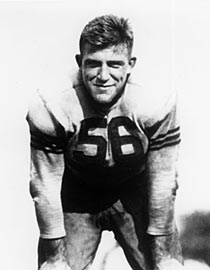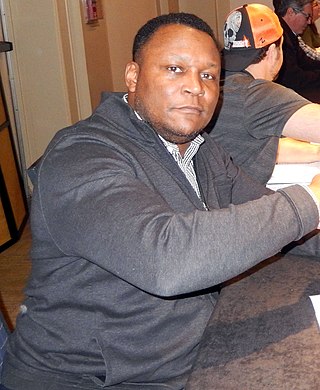
Barry Sanders is an American former football running back who played for the Detroit Lions of the National Football League (NFL) for 10 seasons. Sanders led the league in rushing yards four times and in rushing touchdowns once, establishing himself as one of the most elusive runners in the history of the NFL with his quickness and agility, despite being only 5 ft 8 in tall and weighing 203 lbs. Sanders played college football for the Oklahoma State Cowboys. As a junior in 1988, he compiled what is widely considered the greatest individual season by a running back in college football history, rushing for 2,628 yards and 37 touchdowns in 11 games. He won the Heisman Trophy and was unanimously recognized as an All-American.

Elroy Leon "Crazylegs" Hirsch was an American professional football player, sport executive and actor. He was inducted into the Pro Football Hall of Fame in 1967 and the College Football Hall of Fame in 1974. He was also named to the all-time All-Pro team selected in 1968 and to the National Football League (NFL) 1950s All-Decade Team.

Julius Frazier Peppers is an American former professional football player who was a defensive end and linebacker in the National Football League (NFL). He played college football for the North Carolina Tar Heels, where he was recognized as a unanimous All-American, and was selected by the Carolina Panthers second overall in the 2002 NFL draft, and also played for the Chicago Bears from 2010 through 2013 and the Green Bay Packers from 2014 to 2016. After rejoining the Panthers for the 2017 season, he retired after the 2018 NFL season.

Stephen Wood Van Buren was a Honduran-American football halfback who played for the Philadelphia Eagles of the National Football League (NFL) from 1944 to 1951. Regarded as a powerful and punishing runner with excellent speed, through eight NFL seasons he won four NFL rushing titles, including three straight from 1947 to 1949. At a time when teams played 12 games a year, he was the first NFL player to rush for over ten touchdowns in a season—a feat he accomplished three times—and the first to have multiple 1,000-yard rushing seasons. When he retired, he held the NFL career records for rushing attempts, rushing yards, and rushing touchdowns.

Robert Yale Lary Sr. was an American professional football player, businessman, and politician. He played for 11 seasons as a safety, punter and return specialist for the Detroit Lions of the National Football League (NFL). He was inducted into the Pro Football Hall of Fame in 1979 and was also selected for the NFL 1950s All-Decade Team.

Benjamin Friedman was an American football player and coach, and athletic administrator.

Jack LeRoy Christiansen was an American professional football player who became a college and pro coach. He played professionally in the National Football League (NFL) for the Detroit Lions as a safety and return specialist from 1951 to 1958. He helped lead the Lions to three NFL championships in 1952, 1953, and 1957 and was a first-team All-NFL player in six of his eight years in the league. He led the NFL in interceptions in 1953 and 1957 and in punt returns for touchdown in 1951, 1952, 1954, and 1956. His eight career punt returns for touchdowns was an NFL record until 1989 and remains the fourth best in league history. He was inducted into the Pro Football Hall of Fame in 1970.
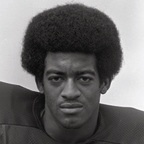
David Steven Brown was an American professional football player who was a cornerback for 15 seasons in the National Football League (NFL) for the Pittsburgh Steelers (1975), Seattle Seahawks (1976–1986), and Green Bay Packers (1987–1989). He was selected as a second-team All-NFL player in 1984 and a second-team All-AFC player in 1985. His 62 career interceptions ranks tied for tenth in NFL history, with only five players having more interceptions in a career since his career ended in 1989. His 50 interceptions with the Seahawks remains a club record.

Peter Louis Pihos was an American football player and coach.

Thomas Lee Mack is an American former football guard who played for the Los Angeles Rams of the National Football League (NFL). He was inducted into the Pro Football Hall of Fame in 1999.
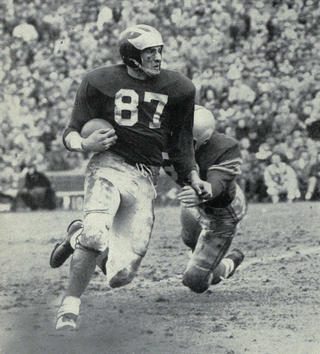
Ronald John Kramer was an American professional football player who was an end in the National Football League (NFL), primarily for the Green Bay Packers. A member of two NFL champion teams with the Packers, he was named to the NFL 50th Anniversary All-Time Team and Green Bay Packers Hall of Fame.
Derrick Scott Alexander is an American college football coach and former professional player who is the head football coach for Avila University, a position he has held since 2023. He played as a wide receiver in the National Football League (NFL).

Terry Albert Barr was an American football player. He played professional football for nine seasons in the National Football League (NFL) for the Detroit Lions from 1957 to 1965. He began his NFL career as a defensive back and return specialist and later became one of the best pass receivers in the NFL. He played in the Pro Bowl in both 1963 and 1964, led the NFL with 13 touchdown receptions in 1963, and was among the NFL leaders with 1,086 receiving yards in 1963 and 1,030 receiving yards in 1964. Over his nine-year NFL career, Barr appeared in 102 games and caught 227 passes for 3,810 yards and 35 touchdowns.

Kenneth William Kavanaugh was an American football player, coach, and scout. He played professionally in the National Football League (NFL) for the Chicago Bears as an end from 1940 to 1950, except for three seasons during which he served in World War II. He led the league in receiving touchdowns twice, and is a member of the NFL 1940s All-Decade Team. He is the Bears' all-time leader in receiving touchdowns, with 50. He retired with the second most receiving touchdowns in NFL history and was the second to reach 50 touchdowns in NFL history.
John Stuart "Jumbo" Elliott is an American former professional football player who was an offensive tackle for 14 years in the National Football League (NFL) with the New York Giants from 1988 to 1995 and the New York Jets from 1996 to 2000 and 2002. He appeared in 197 NFL games, including 156 as a starter. He was a key player on the 1990 New York Giants team that won Super Bowl XXV, received All-Madden honors in 1990 and 1991, and was selected to play in the 1993 Pro Bowl. His signature moment came in October 2000 when he caught the game-tying touchdown pass in the game known as the "Monday Night Miracle".

Reginald McKenzie is an American former professional football player who was a left guard in the National Football League (NFL), primarily for the Buffalo Bills from 1972 to 1982. Selected as a first-team All-NFL player in 1973 and second team in 1974, McKenzie was a key player on the Bills' offensive line that became known as the Electric Company that led the way for O. J. Simpson to become the NFL's first 2,000-yard rusher during the 1973 NFL season.

Albert Timothy Bentley is an American former professional football player who was a running back in the National Football League (NFL) and the United States Football League (USFL). Bentley began his professional career in the USFL with the Michigan Panthers and Oakland Invaders from 1984 to 1985. After the USFL folded, he played for the NFL's Indianapolis Colts and Pittsburgh Steelers from 1985 to 1992. Bentley played college football for the Miami Hurricanes.

Robert Mann was an American professional football player in the National Football League (NFL). A native of New Bern, North Carolina, Mann played college football for the Hampton Pirates in 1942 and 1943 and the Michigan Wolverines in 1944, 1946 and 1947. Playing the end position, he broke the Big Ten Conference record for receiving yards in 1946 and 1947. After not being selected in the 1948 NFL draft, Mann signed his first professional football contract with the Detroit Lions, where he stayed for two seasons. He later played for the Green Bay Packers for parts of five seasons until 1954. Mann broke the color barrier for both teams.
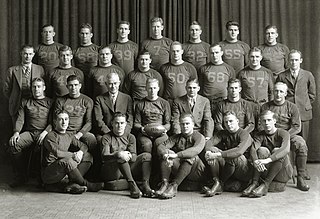
The 1930 Michigan Wolverines football team represented the University of Michigan in the 1930 college football season. The head coach was former Michigan star, 31-year-old Harry Kipke, in his second year in the position.
Herbert Anthony Adderley was an American football cornerback who played for the Green Bay Packers and the Dallas Cowboys of the National Football League (NFL). In 1980, he was enshrined in the Pro Football Hall of Fame.
